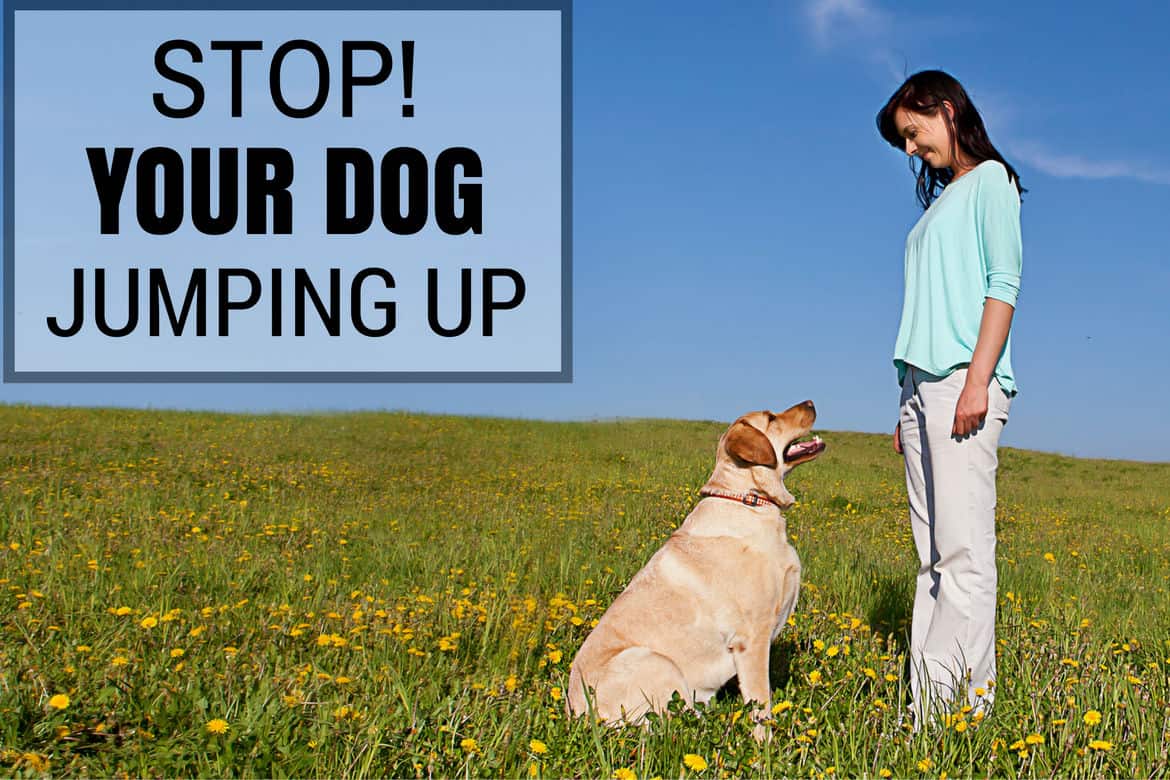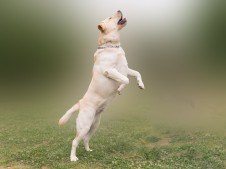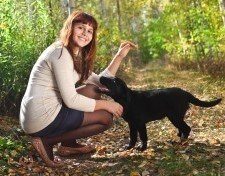This post may contain affiliate links. We may earn money or products from the companies mentioned in this post.

Perhaps the number one reason for owning a dog is to enjoy the unbridled affection they lavish on their family.
After a long, stressful day it’s remarkably energizing to come home to a beloved pet that’s clearly overjoyed to see you. However, it’s possible to have too much of a good thing.
When your dog greets you with love, that’s great, you’re clearly doing an excellent job making your dog feel loved in return.
But when that greeting becomes overly rambunctious and jumping is involved, it becomes a problem.
Left unchecked, this behavior can make those wonderful reunions something you actually dread, and no one wants that.
So, if a jumping dog is your problem, don’t worry; you’re not alone! Even my own 5 year-old Black Lab will occasionally require a gentle reminder. (This is not exclusively puppy behavior!)
In this article you’ll find tips, tricks, and resources that show you how to stop a dog from jumping up and help to keep your dog grounded.
Why Does My Dog Jump Up When He Says Hello?
Before we can correct a behavior, it’s important we first seek to understand it. We need to know why it happens to effectively prevent it from happening again.
Fortunately, as behaviors go, jumping is a relatively simple one to comprehend. In the case of a dog jumping, it’s most likely a result of being a social animal.
No doubt you’ve noticed that when dogs greet one another, there‘s a whole lot of sniffing going on.
Apart from the unintentionally comedic inspection of the private areas, dogs also frequently smell and lick each other’s muzzles.
That’s because a great variety of smells emanate from these parts of the body, and dogs learn a lot by smelling.
With most dogs being relatively close in height, this can be accomplished without a lot of hoopla. But when they’re trying to say hello to a human, well, it can be a long way from the ground to a person’s face!
What you’re seeing is a perfectly natural canine behavior adapted to accommodate their far taller bipedal family and friends.
And if you own one of the more exuberant breeds (which you likely do, if you’re at this site), or almost any puppy or younger dog, they’re even more likely to engage in this behavior.
In contrast, my 12 year-old German Shepherd has zero interest in jumping on people coming through the door, no matter how much she likes them.
Is It Really That Big A Deal?
A jumping dog can cause annoyance, and even injury when you’re dealing with a large breed like a Lab. A jumping puppy is cute, but a dog that weighs 60 or more pounds is a force to be reckoned with.
Small children and the elderly will be no match for a big friendly dog flying through the air. You also don’t want your dog jumping up on someone who is actually afraid of dogs.
For everyone’s comfort and safety, this is a behavior that needs to be corrected.
Is There More to Jumping Than Just Excitement?

There is almost never any underlying medical or physiological issue involved with jumping to say hello.
At worst, you might have a dog that learned this behavior with a previous owner, or perhaps your dog isn’t getting enough exercise and has some extra steam it needs to blow off.
Of course, there is always a chance that your dog is feeling anxious, or insecure, and is looking to you for reassurance and a safe embrace.
A puppy will likely grow out of this behavior, but if you have an older dog showing these tendencies, there may be a more serious underlying problem.
If you suspect your dog may be suffering from anxiety, here’s a resource to help you learn more: Extreme Fear and Anxiety in Dogs – PetMd
The Bad Behavior We Hate To Love
Jumping up is practically unique among unwanted behaviors in that it is frequently rewarded, especially when the dog is young.
A playful puppy jumping on your leg is undeniably adorable, and any dog lover’s natural inclination is to pet and play with said puppy.
Though we may not realize it, attention is a reward, and once a behavior is rewarded, it becomes routine.
Further compounding the problem, rewards for this behavior are regularly doled out by well-intentioned visitors to your home and even complete strangers on the sidewalk, or at the park.
So, even if you as an owner are doing nothing to encourage your dog to jump, it may become a problem anyway. Essentially, your dog has become a victim of its own cuteness!
Ways To Keep Your Dog On The Ground
Remove the Reward
If attention is a reward, then inattention is the obvious deterrent.
I’m not saying to ignore the problem and it’ll go away. But the key to discouraging jumping is to take away the reward your dog is seeking for the behavior.
Your dog is perpetually seeking your approval, and if it doesn’t get it, it soon learns to stop doing those things that don’t elicit a favorable response.
Turn Aside From the Jump
When your dog jumps up at you, the best response is to simply turn away from it. Additionally, you should avoid any eye contact with your dog.
Myself, I also bring my hands up to my chest; many dogs will try to rub their heads on your hands in order to make it very clear what they want.
By removing your hands from the equation, you take away the opportunity for your dog to do this.
Your dog is quite clever, and will likely stop trying to jump when they receive no response.
As soon as they have all four paws on the ground, go ahead and give them a calm and friendly greeting. If the jumping immediately resumes, turn away again until they stop.
Again, when they are fully ‘four on the floor’, offer gentle praise and affection.
Though you may wish to praise your dog with greater enthusiasm, refrain from doing so as it will just encourage them to get excited all over again.
Use Your Words
If your dog is already familiar with the ‘sit’ command, you can incorporate this into your technique. Rather than turning away from your dog, back off and give the command including any hand gesture you might use.
It stands to reason that your dog can’t jump and sit at the same time, so given the chance to do what it’s been asked, your dog will probably choose to do what it already knows will please you.
Again, offer calm praise and a greeting when four feet and a backside are on the floor.
Other commands can be substituted for ‘sit’ if you prefer, such as ‘stay’ or ‘down.’
However, if your dog simply gets too excited to execute these commands properly (as is often the case, especially with puppies) try diverting their attention elsewhere.
Ask them to go find their ball, or a favorite toy, as a way to distract them and expend some energy. And, as always, reward the good behavior with praise.
Show Them the Door

Another way to teach your dog that sitting or standing is the best way to say hello is to use your door as a tool.
If when you cross the threshold your dog moves to jump at you, step back out of the house or room, and close the door. Wait a moment for your dog to calm down, and then try again.
You may need to do this repeatedly, but eventually your dog will catch on to the fact that you won’t come through the door if he’s jumping.
When you open the door to find him nicely sitting or standing, come in and offer him the praise he deserves, and perhaps a treat.
Should I Offer Treats?
A note about treats: They make for excellent rewards, especially with food-driven dogs like Labradors. But, if you’re not careful, your dog may learn that it gets a treat for jumping and THEN sitting.
Use treats sparingly. By mixing up your dog’s rewards (treats, toys, praise, etc.), he won’t have any particular expectations, and won’t automatically connect food with good behavior.
It also saves you the necessity of carrying dog treats on your person at all times!
What To Do About Visitors
Now that we’ve looked at how to stop your dog from jumping on you, we need to figure how to keep him down off visitors to your home.
Strangers can be almost as exciting as owners to a dog, partly because they often greet dogs with extra gusto. How, then, do you get your dog to behave as well for others as he does for you?
Train Your People
The first step will be behavior modification – for your visitors!
When you’re in the process of training your dog to stay down when saying hello, let your friends and family know what you’re up to.
Ask them to please help out by not encouraging the bad behavior through their own actions; have them greet your dog calmly, and ask them to refrain from giving the dog attention if he is having a hard time staying down.
Of course not everyone who comes to your door can be prepped in advance, and there are strangers on the street to contend with too. So you will have to teach your dog how to act in these circumstances.
Phone A Friend
If you have some good friends or family that are willing to help out, you can have them take your place using the same techniques I’ve outlined above.
When your dog has the same behavior reinforced by multiple people, they will learn that this behavior is the right choice when greeting anyone, and not just you.
You might find it useful to perform this training with your dog on a leash, even if you’re in the house.
Using a leash with a harness is an effective way to hinder your dog’s ability to jump up and encourage them to keep ‘four on the floor.’
A collar isn’t recommended for this kind of training, as it can be very hard on your dog’s neck.
Another method you might try with a friend involves a longer approach and is useful for learning how to greet in situations other than at a door.
With your dog on a leash, have a friend (and make sure this friend is someone your dog actually wants to greet!) stand a short distance from your dog, maybe 10-15 feet. Ask your dog to sit, and praise him when he does.
Once your dog is sitting, your friend can begin to approach him. If the dog gets up to move towards your friend, have your friend turn around and walk back the way they came.
Give the command to sit again. When your dog sits, your friend can approach once more.
Repeat this process a few times, and soon your dog will figure out that if he wants to say hello to this person, he’s going to have to sit and wait for them.
Stranger Danger!

Strangers you meet in public present a unique challenge while training your dog not to jump.
Don’t be afraid to let a stranger know that you’re working with your dog to correct this behavior and could they please not pet your dog if it jumps.
Some people recommend having the stranger offer the dog a treat as a reward for not jumping, but I would be hesitant to teach a dog that everyone who approaches him is a potential source of treats.
Two Steps Forward…
Anyone who has helped a dog to learn the difference between acceptable and unacceptable behaviors knows that it’s seldom a linear process.
There will be progress and regression before the ultimate goal is reached, and your dog will go through what are known as ‘behavior extinction bursts’ – quite simply, things may get worse before they get better.
If you see this happening, don’t give up! It’s a natural part of the process, and if you throw in the towel now, you’ll be cementing the bad behavior in place.
Things To Avoid
Now that we’ve covered some good ways to stop your puppy from jumping, it’s important to go over some behaviors for YOU to avoid as you work towards owning a non-ballistic dog.
Raising Your Voice
Much like when you’re trying to teach your dog not to bark in certain situations, yelling at your dog and getting generally loud and animated won’t help.
Most likely your dog will think you’re joining in the fun, which will encourage him to jump even more.
A calm approach is always best.
Knee-Jerk Reaction
There are those who suggest that bringing up your knee to meet the dog’s chest is an effective way to discourage jumping, but this is not recommended.
Standing on one foot puts you off-balance and could cause you to fall over.
Also, you run the risk of injuring your dog with a sharp knee to the ribcage, which may make them afraid to approach you. Clearly not the end result you’re looking for!
In fact, any sort of physical approach to the problem is likely to backfire in some way.
Shoving your dog, or grabbing it by the paws or legs will probably be seen as play, and there’s not much a Lab loves more than to play!
Stick with verbal commands, treats, and praise.
Crating
There’s a school of thought that suggests crating your dog when guests come over gives the dog time to calm down before coming out to socialize.
My personal experience is that my dog now has time to get REALLY wound up and then he bursts out like the Tazmanian Devil in a Bugs Bunny cartoon!
Crating the dog does not directly address the problem behavior, and may seem more like a punishment.
If your dog is aggressive towards outsiders in your home, then crating may be necessary while you work on that issue, perhaps with a professional trainer.
If you want more information about crate training (a valuable part of raising a puppy), try this article: The Ultimate Guide To Crate Training
Final Thoughts
Everyone wants to have the perfect, well-mannered dog that’s always calm and polite (but happy!) when people stop to say hello.
The truth is, while elusive, that very dog is living inside your dog right now! It’s up to you to let him out. It will take time, it will take work, and it will most definitely take patience. But it will all be worth it in the end.
Learn to enjoy your personal welcoming committee, and stop fearing the friskiness!
Save this to Pinterest

Top Picks For Our Dogs
- BEST PUPPY TOY
We Like: Calmeroos Puppy Toy w/ Heartbeat and Heat Packs - Perfect for new puppies. Helps ease anxiety in their new home. - BEST DOG CHEW
We Like: Bones & Chews Bully Sticks - All of our puppies love to bite, nip, and chew. We love using Bully Sticks to help divert these unwanted behaviors. - BEST DOG TREATS
We Like: Crazy Dog Train Me Treats - One of our favorite treats for training our service dog puppies. - BEST FRESH DOG FOOD
We Like: The Farmer's Dog - A couple months ago we started feeding Raven fresh dog food and she loves it! Get 50% off your first order of The Farmer's Dog.
For a list of all the supplies we get for our new service dog puppies check out our New Puppy Checklist on the PuppyInTraining.com blog.
8 comments
Thank-you, I really appreciate this article, and found it to be very helpful.
Thank you I have found your Labrador’s training HQ site really helpful.
Thank you i really did find this very interesting and informative.
Thank you for the help and advise it was very useful and helped me to appreciate I was actually trying to do the right thing. Didn’t think about using a friend to help this is great and hopefully the puppy will appreciate the hard work too.
I’m glad you found it helpful. It’s good to work hard with your puppy when they’re young so they will be well behaved as adults. By the time my Lab, Stetson was 2 years old he was practically perfect in every way. I was training him to be a guide dog so we were working on his training pretty much 24/7. Good luck with your puppy!
Very informative article. Shall try this on my 6 month old Lab who is a darling in every way. The excitement and jumping is just high spirits, but I don’t want it to become a habit. It’s physically a challenge as my husband is 83 and I am 75 but our Bruno is the ideal, friendly new family member. He lights up our days
Hi Suma, how has Bruno progressed? Is he a 4-paws-floor-greeter now?
Psycho Sally has EARNED her nickname. I do believe this 8 month old Lab puppy is half dog and half kangaroo. What amazes me most is sight seems to be a secondary sense. Her nose is her primary. It’s amazing to me how I hide treats around the house and yard then say, “Find that Bone”. She searches fervently and she WILL find that bone within minutes sniffing the air and following her nose. However, jumping up on me and everyone has been a tiresome chore for me and I’m getting nowhere. I met a man in the hardware store who was very familiar with the breed. He saw how she was just going berserk as usual wanting attention and he smiled. We talked and he said ‘get used to it’ for the first year and a half. He said that one day, all of a sudden, a light bulb goes on in their heads and the finally obey and calm down. I was encouraged. She is 8 months old now, only 9 months to go and counting!